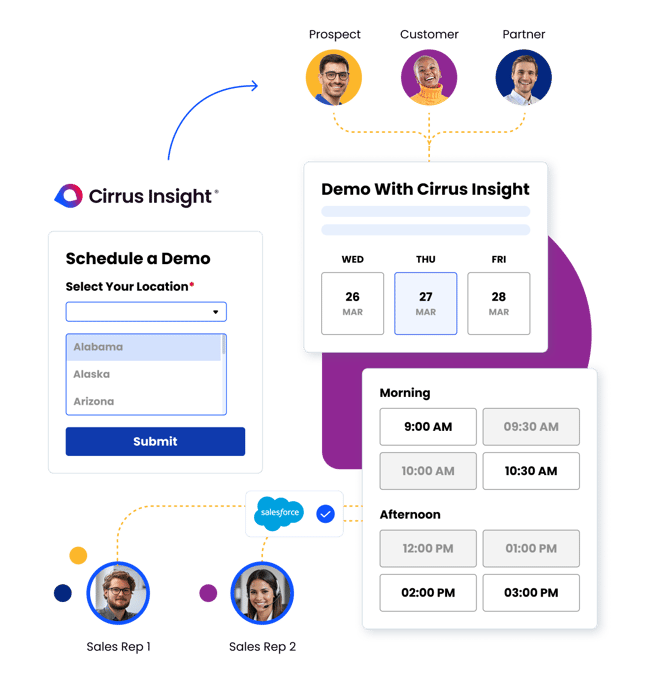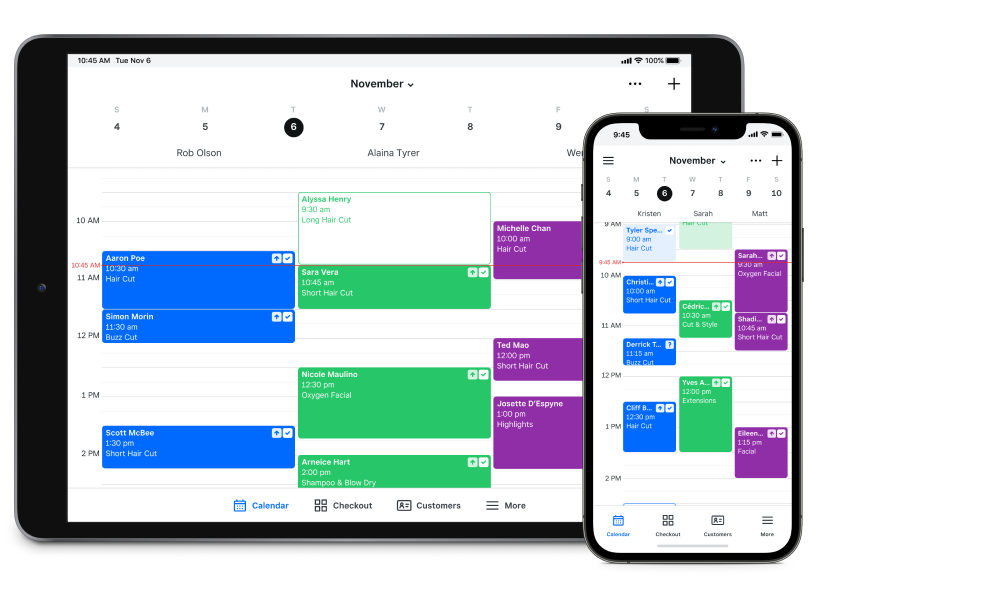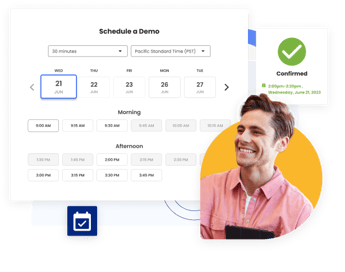- Solutions
-
Products
-
Resources
Sales Automation Tools | Cirrus Insight by Kristi Campbell View all Blog Posts >Get the App, Get the Sidebar, & Get Your Trial Going HereUnleash limitless growth opportunities by partnering with Cirrus Insight.
- Pricing
Filter By:
Best Appointment Scheduling App in 2025 [by Use Case]
If every company says theirs is the best appointment scheduling app, then which one is really the best?
The truth is—it depends. One appointment booking app might have 50+ free features and another with just one essential feature, even behind a paywall, might be the greatest tool ever built simply because it serves your unique business needs.
A lead booking an appointment is a green signal and with the right scheduling experience, you can spend less time on finding the perfect salesperson-to-client fit and more on closing the deal.
This article spotlights the 10 most talked-about appointment scheduling tools. The best part? You don’t need to download them all to decide.
Table of Contents
- The best appointment apps overview
- What is an appointment scheduling app?
- Best appointment scheduling app based on use case
- Benefits of using an appointment scheduling app
- Key features of an ideal appointment scheduling app
- Test if the appointment app fits your needs
The Best Appointment Apps Overview
Looking for a scheduling tool tailored to your business needs? Here’s a quick overview of the top appointment apps featured in this guide, organized by their best-fit use case. Click a name below to jump to the full review:
-
Cirrus Insight Smart Scheduler – Best for sales teams and intelligent lead routing
-
Acuity Scheduling – Best for subscription-based and B2C businesses
-
Picktime – Best for trainers, classes, and invoice management
-
Square Appointments – Best for service businesses with product sales
-
SimplyBook.me – Best for building a branded booking experience
-
Calendly – Best for simple, one-off meeting scheduling
-
Cal.com – Best for developers and custom workflow automation
-
Zoho Bookings – Best for team consultations
-
Appointy – Best for service-focused businesses managing flexible schedules
-
Book Like A Boss – Best for entrepreneurs needing client-facing booking pages
What is an Appointment Scheduling App?
An appointment scheduling app is a digital tool designed to automate the process of booking, managing, and tracking appointments—helping individuals and businesses reduce manual scheduling, avoid conflicts, and stay organized. These apps streamline calendar coordination, eliminate back-and-forth communication, and enhance overall efficiency.
Key features often include:
-
Automated appointment booking and confirmations
-
Calendar syncing across platforms (Google, Outlook, etc.)
-
Customizable time slot availability and buffer settings
-
Automatic reminders and follow-ups

Best Appointment Scheduling App Based on Use Case
Best for Sales and Lead Routing
Cirrus Insight Smart Scheduler
-
Free Plan: No
-
Base Plan: $14/seat/month
-
Supported Calendars: Google, Outlook
-
Key Integrations: Salesforce, Zoom, Google Workspace, Microsoft Outlook
-
Available On: iOS, Android, Web
What it does best:
Helps sales teams book more qualified meetings by automatically routing prospects to the right rep based on skill, territory, availability, or product expertise.
Key Features:
-
Intelligent Lead Routing: Custom rules ensure prospects are matched with the right salesperson.
-
Salesforce Sync: Auto-log meetings directly to CRM with contextual data.
-
Custom Booking Pages: Tailored experiences with surveys and branding.
Pros:
-
Ideal for teams using Salesforce
-
Powerful lead matching and routing
-
Custom attributes for precise calendar selection
Cons:
-
No free version
-
Built specifically for sales and revenue teams—may be overkill for general use
Use it if: You want a scheduling tool that increases lead conversion and integrates deeply with Salesforce.

Best for Subscription-Based or B2C Businesses
Acuity Scheduling
-
Free Plan: No
-
Base Plan: $20/seat/month
-
Supported Calendars: Google, Outlook
-
Key Integrations: Stripe, PayPal, Zapier, Mailchimp, Instagram, Facebook, Squarespace
What it does best:
Handles recurring bookings, subscriptions, and custom payment flows with ease.
Key Features:
-
Payment Integration: Collect deposits, tips, or full payments upfront.
-
Packages & Memberships: Sell bundled appointments and offer loyalty discounts.
-
Controlled Availability: Limit bookings and cancelations for better time control.
Pros:
-
Great for coaches, salons, and therapists
-
Built-in payment and customer management features
-
Strong branding and personalization options
Cons:
-
Slight learning curve for feature setup
-
No free tier
Use it if: You're running a client-facing business that needs flexible payment and subscription options.
Best for Trainers, Classes, and Invoice Management
Picktime
-
Free Plan: Yes
-
Base Plan: $4/seat/month
-
Supported Calendars: Google, Outlook
-
Key Integrations: Zoom, Stripe, Square, Microsoft Teams, Zapier
What it does best:
Combines class booking, invoicing, and reporting in one platform.
Key Features:
-
Class Capacity Management: Prevent overbookings with attendance limits.
-
Invoice Generation: Manage billing alongside scheduling.
-
Team Off-Day Tracking: Admin-friendly tools for managing team availability.
Pros:
-
Extremely affordable
-
Ideal for fitness, training, or workshops
-
Includes invoice + refund features
Cons:
-
Less polished UX than premium tools
-
May not scale for large teams
Use it if: You run classes, workshops, or client sessions and want simple scheduling with billing tools.
Best for Hybrid Scheduling + Online Sales
Square Appointments
-
Free Plan: Yes (for individuals)
-
Base Plan: $29/location
-
Supported Calendars: Google
-
Key Integrations: QuickBooks, MailChimp, Wix, WordPress, Google
What it does best:
Seamlessly combines appointment booking with product sales and inventory management.
Key Features:
-
Waitlists + Class Booking: Manage recurring sessions with capacity settings.
-
Integrated Website: Sell services and products on a customizable website.
-
Text/Email Reminders: Reduce no-shows with auto-reminders.
Pros:
-
Built-in POS and payment handling
-
Great for service-based businesses and retail
-
Free tier available
Cons:
-
Per-location pricing adds up for multi-site businesses
-
Limited CRM capabilities
Use it if: You’re offering both services and products and want one platform to handle both.

Best for Building a Branded Booking Experience
SimplyBook.me
-
Free Plan: Yes
-
Base Plan: €8.25/month for 5 users
-
Supported Calendars: Google, Outlook
-
Key Integrations: Stripe, Zapier, Google Analytics, FreshBooks
What it does best:
Offers complete flexibility with web widgets, booking sites, and branded tools.
Key Features:
-
Website Builder: Create a custom booking site with themes and SEO tools.
-
Multiple Location Support: Manage bookings across regions or offices.
-
Client Management: Built-in CRM-like tools and reporting.
Pros:
-
Powerful customization
-
Great for agencies or multi-location brands
-
White-labeling and API available
Cons:
-
Setup can be time-consuming
-
May feel feature-heavy for solo users
Use it if: You want full control over branding and multiple booking websites.
Best for One-Off Appointments
Calendly
-
Free Plan: Yes
-
Base Plan: $12/seat/month
-
Supported Calendars: Google, Outlook
-
Key Integrations: Zoom, Stripe, PayPal, HubSpot, Google Meet
What it does best:
Keeps scheduling simple, professional, and quick.
Key Features:
-
Time-Zone Syncing: Avoid confusion with automatic time zone detection.
-
Multiple Event Types: Offer a variety of meeting lengths and types.
-
Buffer & Notice Times: Prevent last-minute bookings or overbooking.
Pros:
-
Intuitive and easy to use
-
Affordable for individuals or small teams
-
Plenty of integrations via Zapier
Cons:
-
Limited customization options
-
Fewer features for enterprise or routing
Use it if: You want a clean, simple way to send booking links via email.
Best for Developers and Custom Workflows
Cal.com
-
Free Plan: Yes
-
Base Plan: $15/seat/month
-
Supported Calendars: Google, Outlook
-
Key Integrations: Zoom, SMS, Typeform
What it does best:
Open-source customization and workflow automation.
Key Features:
-
In-House Video Calls: Use Cal Video or integrate Zoom/Meet.
-
Automated Workflows: Set pre- and post-meeting processes.
-
One-Time Booking Links: Share expiring links for limited access.
Pros:
-
Developer-friendly (open-source)
-
High customization potential
-
Scales with complex workflows
Cons:
-
Best for technical users
-
Interface not as polished as mainstream options
Use it if: You want granular control over scheduling logic and automated flows.

Best for Consultations
Zoho Bookings
-
Free Plan: Yes
-
Base Plan: $9/seat/month
-
Supported Calendars: Google, Outlook
-
Key Integrations: Zoho CRM, Zoom
What it does best:
Streamlines appointment management for teams already using Zoho tools.
Key Features:
-
Recurring Group Bookings: Coordinate ongoing team sessions.
-
Revenue Reporting: Track earnings and performance at a glance.
-
Branded Domains: Customize URLs and sender email identities.
Pros:
-
Strong integration with Zoho ecosystem
-
Affordable pricing
-
Built-in reporting
Cons:
-
Limited integrations outside Zoho suite
-
Lacks advanced routing
Use it if: You’re already using Zoho CRM and want a native scheduling add-on.
Best for Service-Focused Businesses
Appointy
-
Free Plan: Yes
-
Base Plan: $29/seat/month
-
Supported Calendars: Google, Outlook
-
Key Integrations: Zoom, Facebook, PayPal, Squarespace
What it does best:
Makes it easy for clients to book recurring or time-sensitive appointments.
Key Features:
-
Flexible Availability: Manage irregular and holiday schedules.
-
Restricted Booking: Create windows where only specific users can book.
-
Intuitive UX: User-friendly interface with fast setup.
Pros:
-
Easy to use for admins and clients
-
Great for salons, consultants, and service techs
-
Built-in analytics
Cons:
-
Higher base price for solo users
-
Limited advanced integrations
Use it if: You want a user-friendly tool that helps manage shifting schedules and recurring appointments.
Best for Entrepreneurs
Book Like A Boss
-
Free Plan: No
-
Base Plan: $10/seat/month
-
Supported Calendars: Google, Outlook
-
Key Integrations: Stripe, Square, Zoom, Dubb, Mailchimp
What it does best:
Combines scheduling, marketing, and client communication in one.
Key Features:
-
Multiple Booking Pages: Tailor experiences for different service offerings.
-
Custom Forms + Discounts: Collect client info and create limited offers.
-
Client Dashboard: Track preferences, history, and upcoming meetings.
Pros:
-
Strong branding and marketing features
-
Affordable for solo businesses
-
Ecommerce-like functionality
Cons:
-
No free plan
-
Not ideal for larger teams
Use it if: You're a solo consultant, coach, or freelancer who wants a professional, all-in-one booking presence.
Benefits of Using an Appointment Scheduling App
-
Save time and boost productivity: Automate scheduling tasks like email confirmations, time blocking, and availability management to reduce back-and-forth communication and focus more on meaningful work.
-
Reduce missed appointments: Built-in reminders and conflict-checking features help ensure meetings happen as planned, minimizing no-shows and last-minute rescheduling.
-
Enhance client experience: Provide customers with an easy, intuitive way to book time that works for both sides—improving convenience and creating a more personalized experience.
-
Improve internal coordination: Give teams greater visibility into each other's calendars, making it easier to align schedules and avoid overlaps.
-
Support global and remote teams: Automatically adjust for time zones so distributed teams and international clients can seamlessly schedule meetings without confusion.
Appointment Scheduling Software Key Features
When choosing an appointment scheduling tool, look for features that streamline the booking process, reduce friction, and route meetings to the right people at the right time.
Essential Features
-
Calendar and Email Integration: Sync with tools like Google, Outlook, and Salesforce to reflect real-time availability and avoid double-booking.
-
Mobile Accessibility: Ensure clients and team members can schedule or manage appointments on the go, from any device.
-
Automated Reminders: Reduce no-shows with email and/or SMS reminders sent before each appointment.
-
Custom Booking Pages: Match your brand and allow customization of meeting types, durations, and availability rules.
-
Buffer Times: Add time between meetings to prevent back-to-back bookings and give team members time to reset.
-
Time Zone Detection: Automatically adjusts for both the scheduler’s and recipient’s time zones, supporting remote and global teams.
-
CRM Integration: Log meetings automatically to systems like Salesforce, and associate them with the correct contact or account.
-
Security and Compliance: Ensure data protection and support for compliance frameworks like GDPR, HIPAA, or SOC 2.
Advanced Features
-
AI-Powered Routing: Direct meetings to the right team member based on skillset, availability, or customer profile.
-
SMS Follow-Ups and Confirmations: Offer a convenient way to keep clients informed and reduce missed appointments.
-
Payment Integrations: Allow clients to pay for services during the booking process using secure, built-in payment tools.

Test if the Appointment App Fits Your Needs
Before choosing an appointment scheduling app, it’s important to evaluate how well it aligns with your business workflows, customer experience goals, and existing tech stack. The right tool should simplify your scheduling process, not add friction—so prioritize functionality that matches your day-to-day needs.
In our reviews, each app was tested or evaluated based on ease of use, user interface design, platform reliability, feature flexibility, and overall value. We considered how intuitive the setup is, how well it integrates with common tools like Google Calendar or Salesforce, and whether it supports key features like reminders, branding, or mobile access. For teams, we also looked at scalability, user management, and routing logic.
Here’s a checklist of must-have features based on different business types:
Solo Consultants & Freelancers
-
Easy calendar sync (Google or Outlook)
-
Customizable booking pages
-
Email or SMS reminders
-
Basic CRM or client tracking
-
Affordable or free plan options
Sales Teams
-
CRM integration (e.g., Salesforce, HubSpot)
-
Lead routing and round-robin scheduling
-
Team availability management
-
Custom form fields for qualifying prospects
-
Performance reporting and analytics
Service-Based Businesses
-
Payment processing (Stripe, PayPal, Square)
-
Packages, subscriptions, and add-ons
-
Class and group booking support
-
Branded booking pages or websites
-
Mobile accessibility for clients and staff
Global or Remote Teams
-
Time zone detection and syncing
-
Multi-calendar integration
-
Cross-platform (web, iOS, Android) support
-
Workflow automation and notifications
-
Role-based access or multi-user management
Make sure to test each platform with a free trial or demo when available—your day-to-day experience with the tool will tell you more than just a feature list ever could.
Conclusion
We’ve provided the best-in-class appointment booking apps for businesses but it’s now up to you to determine which features are the most useful to your business—both short-term and as you scale.
Operationalize your external scheduling processes. Make it simple for your prospects and customers to schedule a meeting with your Sales, Customer Success (and more) teams.
Whether you need individual calendar options, team calendar links, or complex and customizable logic to direct your prospect to the right calendar, Cirrus Insight has a solution to meet your needs.
Frequently Asked Questions (FAQs)
Which scheduling app is best for you?
The best scheduling app depends on your specific needs. For sales teams using Salesforce, Cirrus Insight Smart Scheduler is ideal for lead routing and CRM syncing. If you’re a solo consultant or small business owner, tools like Book Like A Boss or Calendly may be more appropriate. For those managing classes or recurring services, Picktime and Square Appointments are great options. Review the Top Appointment Scheduling Apps section to compare based on pricing, integrations, and use cases.
Do I need a scheduling app if I have a calendar app?
Yes—calendar apps are great for personal organization, but they don’t automate the booking process. Scheduling apps reduce manual coordination by letting others view your availability, book time, and receive automated confirmations and reminders. This helps prevent double-booking, improves time management, and creates a better experience for clients or teammates.
Is Calendly free to use?
Yes, Calendly offers a free plan that includes basic one-on-one meeting scheduling, calendar integrations, and email notifications. It’s a great starting point for individuals, though teams may need to upgrade to a paid plan for advanced features like round-robin scheduling, CRM integrations, and analytics.
Does Google have a free appointment scheduling tool?
Yes, Google offers a built-in appointment scheduling feature called Appointment Slots within Google Calendar (available for Google Workspace users). It allows people to reserve time on your calendar during open blocks you define. While it's helpful for basic needs, it lacks some of the advanced automation, customization, and branding features found in dedicated scheduling tools.
Which is the best scheduling app for iPhone?
Most major scheduling apps, including Cirrus Insight Smart Scheduler, Calendly, Square Appointments, and SimplyBook.me, offer full-featured iOS apps. For iPhone users who want mobile-first convenience with robust functionality, Square Appointments stands out for service businesses, while Calendly is best for one-time use.
Which is the best scheduling app for Android?
On Android, apps like Picktime, Zoho Bookings, and Cal.com offer solid performance. Picktime is particularly good for managing both bookings and invoicing on the go. If you need something developer-friendly or customizable, Cal.com offers open-source flexibility and Android compatibility.
Eliminate Scheduling Friction
Intelligently match buyers with staff based on personalization criteria, availability & utilization.



.png?width=1268&height=1772&name=Sidebar-C%20(1).png)


